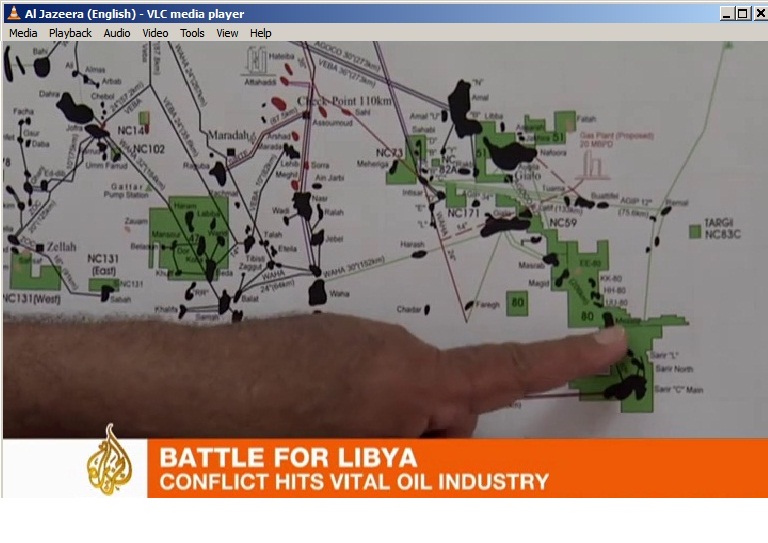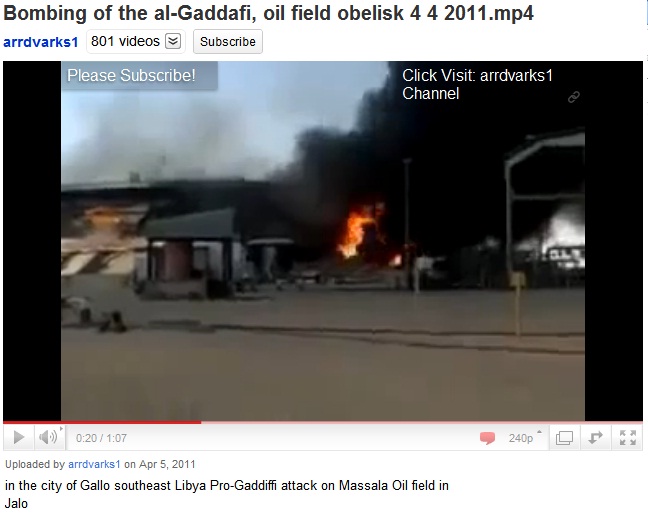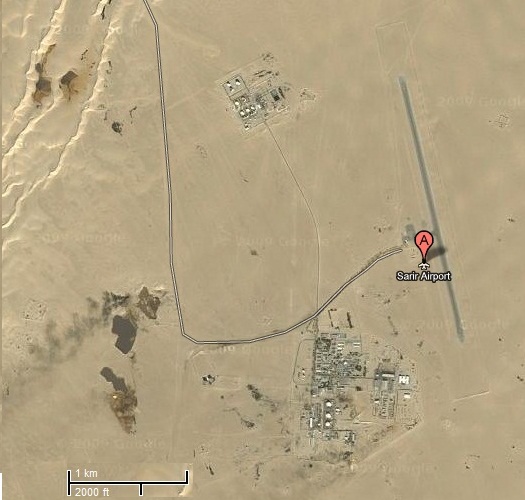Gaddafi forces have attacked and damaged a pumping station at Messlah, North of the Sarir field, in the South East of Libya, depriving Benghazi of oil revenue. A 1990 report on this field suggests it could be depleted by up to 60%. While the media continuously parrot that Libya has the largest oil reserves in Africa, thereby giving the false impression of vast oil riches to be tapped easily, little attention is given to the actual depletion level in producing fields and the technical challenges to get the 2nd half of oil out from these maturing fields. Not to mention the added problem of security in what now appears to be a civil war which is unlikely to end quickly. Moreover, who tells the public that African crude oil exports have peaked in 2007, even before the Libyan crisis?

So here is where the attack took place, the pipeline to Tobruk can be seen on the right:
http://english.aljazeera.net/news/africa/2011/04/201145115121209216.html
http://www.youtube.com/watch?v=yuLuAt0OLc4
In the above Al Jazeera link there is a video report on the current state of the Libyan oil industry
http://www.youtube.com/watch?v=atrR9p4tI1s
The title of this video is confusing and google map is not sufficiently up-to-date to check the type of oil installations, so there is no way of locating this accurately but this is supposed to be Messlah, North of the Sarir field.
From this 1990 document “Sarir field”
Initial, in place reserves of the main field were estimated to be approximately 12 bn bbl of oil of which 6.5 bn should be recoverable along with some 1 tcf of gas. Accurate production figures since 1971, when the field was appropriated by the Libyan government, are not available, but it is estimated that 1,5 bn bbl of oil had been produced by 1983.
http://www.searchanddiscovery.net/documents/sarir/images/lewis.pdf
p. 255, for the C field, we have:
Oil originally in place 12 Gb
Recoverable 6.5 Gb (recovery factor 54%, quite high)
Produced up to 1983 1.5 Gb
Production 1983 243 Kb/d
WEO 2005 has 233 Kb/d in 2004
Cumulative production 1983-2010 estimated at 0.243 x 365 x 27 = 2.4 Gb
Therefore (1.5+2.4)/6.5 = 6o% depleted
Let us assume that in the meantime the initial oil in place was increased by 10% and the recovery factor could be lifted to 60%, then the Sarir oil field would still be at the depletion midpoint.
Libya rebels cut oil flow to Tobruk amid uncertainty over exports
11/4/2011
Libya’s rebel-led National Transitional Council has reduced the flow of crude oil from fields under its control to storage tanks in the port of Tobruk by 75% with no word as to when they will be able to sell a second cargo of crude oil, a source at the 20,000 b/d Tobruk refinery said Monday.
The source did not say how much crude oil was still being held in storage at the Mediterranean oil terminal of Marsa El Hariga near Tobruk. The terminal has 4 million barrels of oil storage capacity of which 3 million barrels is usable.
A petroleum engineer at Tobruk said the government troops attacked power lines feeding the Sarir oil field, forcing a halt in production. Earlier reports had suggested that the attack knocked out the export pipeline to Tobruk but the source said the pipeline was intact.
There have been conflicting reports about the status of oil production from Sarir, Libya’s biggest oil field. The Qadhafi government accused UK war planes of bombing the field and the pipeline while the rebels said Qadhafi’s militias had bombed the installations.
Sarir, which contains an estimated 12 billion barrels of crude oil reserves, is operated by the Arabian Gulf Oil Co., which broke away from the National Oil Company and is now operated by Libyan rebels. The field lies in the prolific eastern Sirte Basin, home to 37 billion barrels of Libyan reserves, roughly 80% of total reserves, estimated at 47 billion barrels.
The rebels have said the two fields were producing 100,000-120,000 b/d of crude oil, less than half normal output. Sarir and the nearby Nafoora oil field were producing 340,000 b/d before the crisis.
The rebel newspaper Libya al-Youm reported April 7 that Qadhafi’s brigades had attacked another oil field, 103 Kilo, near the southeastern town of Ougela. It said the field was operated by the Zueitina Oil Company, which accounted for some 70,000 b/d of Libyan output.
http://www.platts.com/RSSFeedDetailedNews/RSSFeed/Oil/8774507
Well, 12 Gb were the original oil in place (total oil contained in the rock irrespective of whether this oil can be economically or technologically produced), not remaining reserves. That is how the public is being misinformed. And Platts is actually a professional web site of the oil and gas industry.
BTW, the IEA estimated in its WEO 2005 that existing fields in Libya would peak in 2012 at around 2 mb/d (actual production in 2009 was 1.65 mb/d) and then decline at 1.7% pa.
Previous posts:
24/3/2011 Libya: yet another (peak) oil war
http://www.crudeoilpeak.com/?p=2759
24/2/2011 Libya exports 7% of crude from Mediterranean and Middle East
http://www.crudeoilpeak.com/?p=2633
23/2/2011 Quick primer on Libyan oil
http://www.crudeoilpeak.com/?p=2621


